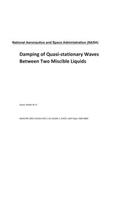
Damping of Quasi-Stationary Waves Between Two Miscible Liquids
Series:
Two viscous miscible liquids with an initially sharp interface oriented vertically inside a cavity become unstable against oscillatory external forcing due to Kelvin-Helmholtz instability. The instability causes growth of quasi-stationary (q-s) waves at the interface between the two liquids. We examine computationally the dynamics of a four-mode q-s wave, for a fixed energy input, when one of the
NaN
VOLUME
English
Paperback

Two viscous miscible liquids with an initially sharp interface oriented vertically inside a cavity become unstable against oscillatory external forcing due to Kelvin-Helmholtz instability. The instability causes growth of quasi-stationary (q-s) waves at the interface between the two liquids. We examine computationally the dynamics of a four-mode q-s wave, for a fixed energy input, when one of the components of the external forcing is suddenly ceased. The external forcing consists of a steady and oscillatory component as realizable in a microgravity environment. Results show that when there is a jump discontinuity in the oscillatory excitation that produced the four-mode q-s wave, the interface does not return to its equilibrium position, the structure of the q-s wave remains imbedded between the two fluids over a long time scale. The damping characteristics of the q-s wave from the time history of the velocity field show overdamped and critically damped response; there is no underdamped oscillation as the flow field approaches steady state. Viscous effects serve as a dissipative mechanism to effectively damp the system. The stability of the four-mode q-s wave is dependent on both a geometric length scale as well as the level of background steady acceleration. Duval, Walter M. B. Glenn Research Center NASA/TM-2002-211694, NAS 1.15:211694, E-13425, AIAA Paper 2002-0890...
Price Comparison [India]
In This Series
Bestseller Manga
Trending NEWS




















